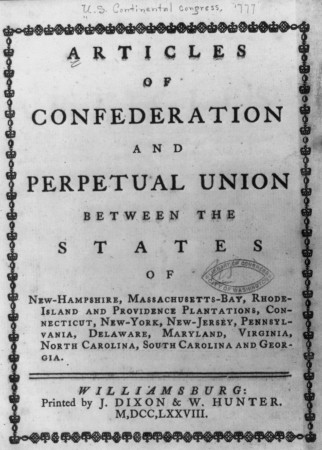Amidst the crucible of the American Revolutionary War, a pivotal moment unfolded on November 15, 1777, as the Second Continental Congress undertook a momentous step in the formation of a new nation. The adoption of the Articles of Confederation marked a foundational chapter in the embryonic republic’s journey toward unity and self-governance.
The Event:
During the tides of conflict and fervent aspirations for sovereignty, the assembled delegates, representing the original 13 colonies, ratified the Articles of Confederation. This early blueprint for an American government aimed to consolidate the disparate states under a unified entity, establishing a loose confederation and outlining the fundamental principles for governance.
The Articles presented a fragile balance, aiming to empower the states while preserving a federal structure. This initial attempt at crafting a national government faced subsequent challenges, eventually paving the way for the more robust Constitution in later years.

Fascinating Facts for Kids:
- Balancing Power: The Articles of Confederation aimed to set up a system where states could have their own rules but agreed to join together for some things, like protection against other countries. It was like keeping a balance, trying to have unity without taking away each state’s individual powers.
- Limited Government: This plan didn’t give the central government a lot of power. It couldn’t collect taxes or make rules about trade. This made it tough for the country to work together smoothly and was a reason why they made a new set of rules later called the Constitution.
- Starting Point: The Articles of Confederation were like a first step in trying to figure out how the country should work together. Even though it had some issues, it taught important lessons that helped the country make a better plan later.
Engaging Learning Activities for Kids:
- Create Your Government: Children can design their basic governance system, emphasizing the balance between state and federal powers, fostering a deeper understanding of governance principles.
- Historical Simulation: Kids can engage in a role-playing activity depicting the deliberations of the Continental Congress, experiencing the challenges and compromises in shaping the nation’s early government.
- Debating the Articles: Encourage a discussion or debate on the merits and limitations of the Articles of Confederation, fostering critical thinking about governance.
Conclusion:
The adoption of the Articles of Confederation on November 15, 1777, marked a seminal moment in American history. While this initial attempt at national governance had its shortcomings, it set the stage for the development of a more robust and enduring federal system. It laid the groundwork for understanding the delicate balance between state autonomy and federal authority, becoming a cornerstone in the evolution of the United States’ governance structure.







What do you think?
Show comments / Leave a comment